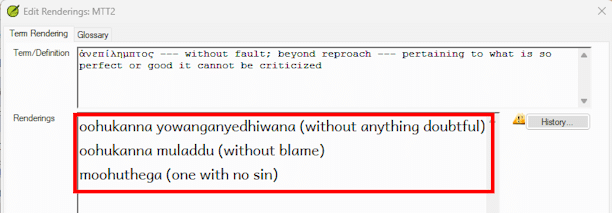A Biblical term may have multiple renderings
Preparing for a checking session, a consultant notices three different renderings for the Greek term ἀνεπίλημπτος (anepilēmptos) ‘beyond reproach’ and legitimately asks “What are the differences between these three?”
When a single Biblical term has multiple approved renderings, it can be difficult for the translators and the consultant to be sure each approved rendering is valid. In addition, they want to be sure that different senses from the source text are being rendered in the translation. Consider the three different renderings for ‘beyond reproach’ in the MTT2 project.
Accounting for multiple senses can validate multiple renderings
In the project renderings for ἀνεπίλημπτος (anepilēmptos) meaning ‘beyond reproach,’ we require additional information to better understand the specific implications and nuances of each potential translation.
In the Edit Renderings dialog, we can add a comment in parentheses just after each different rendering of the Biblical term. This extra material is ignored by the tool if it is within parentheses; it is not considered part of the approved rendering by the Biblical Terms tool.
This feature can also be used to distinguish between senses in the Biblical languages, and it can be used to explain (in brief) why a Greek or Hebrew term needs several approved renderings.
When finished, the Edit Renderings dialog shows each different rendering, with a brief explanation in parentheses.
Note: We can also summarize distinct senses in the Description field, if you wish to give a longer explanation of the different renderings and how those decisions were made.
Now the translation consultant has the information he or she needs to discuss how to translate anepilēmptos. Also, in the future if new translators join the team, they can learn what choices have been made for key terms.
Review of adding renderings to the Biblical Terms tool
If you would like to review how to add renderings to the Biblical terms tool, then consider watching these videos:
Introduction to the Biblical Terms Tool:
Adding a Rendering:
How to Edit or Delete a Rendering:
Conclusion
Paratext allows you to put glosses or other comments within parenthesis next to renderings in the Biblical Terms tool for the benefit of translators and consultants. These comments can be used to explain both nuances of meaning needed for different contexts, and to account for different senses of the Hebrew and Greek words being translated. Having the information right in the Biblical Terms tool will facilitate decisions on the final approved renderings for your Biblical terms. It will also provide important details for new members who may join the team, and for those who may revise your translation in the future. Consider using this feature of the Biblical Terms tool to document those renderings that are not completely straight forward.
For a step-by-step guide and detailed explanation, see the full article: Managing Multiple Senses in the Biblical Terms Tool.


